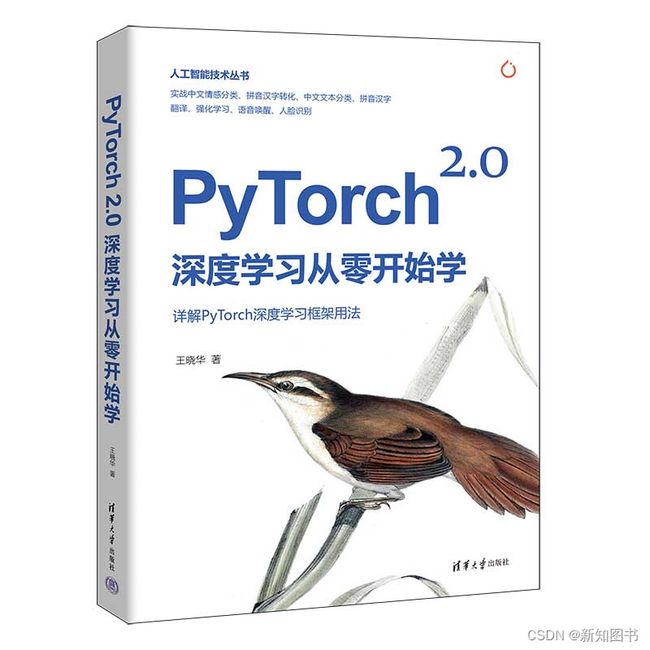实战:基于卷积的MNIST手写体分类
前面实现了基于多层感知机的MNIST手写体识别,本章将实现以卷积神经网络完成的MNIST手写体识别。
1. 数据的准备
在本例中,依旧使用MNIST数据集,对这个数据集的数据和标签介绍,前面的章节已详细说明过了,相对于前面章节直接对数据进行“折叠”处理,这里需要显式地标注出数据的通道,代码如下:
import numpy as np
import einops.layers.torch as elt
#载入数据
x_train = np.load("../dataset/mnist/x_train.npy")
y_train_label = np.load("../dataset/mnist/y_train_label.npy")
x_train = np.expand_dims(x_train,axis=1) #在指定维度上进行扩充
print(x_train.shape)这里是对数据的修正,np.expand_dims的作用是在指定维度上进行扩充,这里在第二维(也就是PyTorch的通道维度)进行扩充,结果如下:
(60000, 1, 28, 28)
2. 模型的设计
下面使用PyTorch 2.0框架对模型进行设计,在本例中将使用卷积层对数据进行处理,完整的模型如下:
import torch
import torch.nn as nn
import numpy as np
import einops.layers.torch as elt
class MnistNetword(nn.Module):
def __init__(self):
super(MnistNetword, self).__init__()
#前置的特征提取模块
self.convs_stack = nn.Sequential(
nn.Conv2d(1,12,kernel_size=7), #第一个卷积层
nn.ReLU(),
nn.Conv2d(12,24,kernel_size=5), #第二个卷积层
nn.ReLU(),
nn.Conv2d(24,6,kernel_size=3) #第三个卷积层
)
#最终分类器层
self.logits_layer = nn.Linear(in_features=1536,out_features=10)
def forward(self,inputs):
image = inputs
x = self.convs_stack(image)
#elt.Rearrange的作用是对输入数据的维度进行调整,读者可以使用torch.nn.Flatten函数完成此工作
x = elt.Rearrange("b c h w -> b (c h w)")(x)
logits = self.logits_layer(x)
return logits
model = MnistNetword()
torch.save(model,"model.pth")
这里首先设定了3个卷积层作为前置的特征提取层,最后一个全连接层作为分类器层,需要注意的是,对于分类器的全连接层,输入维度需要手动计算,当然读者可以一步一步尝试打印特征提取层的结果,依次将结果作为下一层的输入维度。最后对模型进行保存。
3. 基于卷积的MNIST分类模型
下面进入本章的最后示例部分,也就是MNIST手写体的分类。完整的训练代码如下:
import torch
import torch.nn as nn
import numpy as np
import einops.layers.torch as elt
#载入数据
x_train = np.load("../dataset/mnist/x_train.npy")
y_train_label = np.load("../dataset/mnist/y_train_label.npy")
x_train = np.expand_dims(x_train,axis=1)
print(x_train.shape)
class MnistNetword(nn.Module):
def __init__(self):
super(MnistNetword, self).__init__()
self.convs_stack = nn.Sequential(
nn.Conv2d(1,12,kernel_size=7),
nn.ReLU(),
nn.Conv2d(12,24,kernel_size=5),
nn.ReLU(),
nn.Conv2d(24,6,kernel_size=3)
)
self.logits_layer = nn.Linear(in_features=1536,out_features=10)
def forward(self,inputs):
image = inputs
x = self.convs_stack(image)
x = elt.Rearrange("b c h w -> b (c h w)")(x)
logits = self.logits_layer(x)
return logits
device = "cuda" if torch.cuda.is_available() else "cpu"
#注意记得将model发送到GPU计算
model = MnistNetword().to(device)
model = torch.compile(model)
loss_fn = nn.CrossEntropyLoss()
optimizer = torch.optim.SGD(model.parameters(), lr=1e-4)
batch_size = 128
for epoch in range(42):
train_num = len(x_train)//128
train_loss = 0.
for i in range(train_num):
start = i * batch_size
end = (i + 1) * batch_size
x_batch = torch.tensor(x_train[start:end]).to(device)
y_batch = torch.tensor(y_train_label[start:end]).to(device)
pred = model(x_batch)
loss = loss_fn(pred, y_batch)
optimizer.zero_grad()
loss.backward()
optimizer.step()
train_loss += loss.item() # 记录每个批次的损失值
# 计算并打印损失值
train_loss /= train_num
accuracy = (pred.argmax(1) == y_batch).type(torch.float32).sum().item() / batch_size
print("epoch:",epoch,"train_loss:", round(train_loss,2),"accuracy:",round(accuracy,2))
在这里,我们使用了本章新定义的卷积神经网络模块作为局部特征抽取,而对于其他的损失函数以及优化函数,只使用了与前期一样的模式进行模型训练。最终结果如下所示,请读者自行验证。
(60000, 1, 28, 28)
epoch: 0 train_loss: 2.3 accuracy: 0.11
epoch: 1 train_loss: 2.3 accuracy: 0.13
epoch: 2 train_loss: 2.3 accuracy: 0.2
epoch: 3 train_loss: 2.3 accuracy: 0.18
…
epoch: 58 train_loss: 0.5 accuracy: 0.98
epoch: 59 train_loss: 0.49 accuracy: 0.98
epoch: 60 train_loss: 0.49 accuracy: 0.98
epoch: 61 train_loss: 0.48 accuracy: 0.98
epoch: 62 train_loss: 0.48 accuracy: 0.98
Process finished with exit code 0
本文节选自《PyTorch 2.0深度学习从零开始学》,本书实战案例丰富,可带领读者快速掌握深度学习算法及其常见案例。
